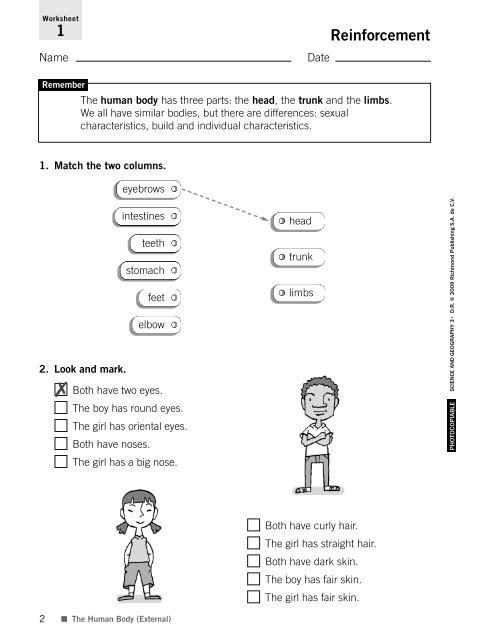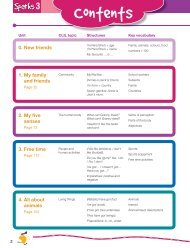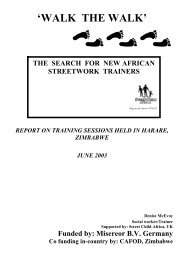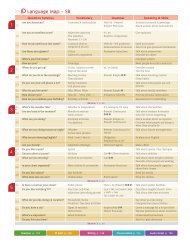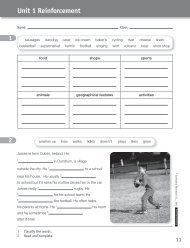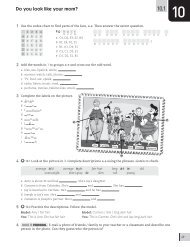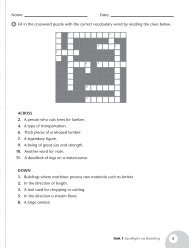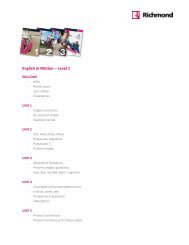PHOTOCOPIABLE
Science and geography 3 - Resource Booklet.qxd
Science and geography 3 - Resource Booklet.qxd
- No tags were found...
You also want an ePaper? Increase the reach of your titles
YUMPU automatically turns print PDFs into web optimized ePapers that Google loves.
Worksheet<br />
1<br />
Name<br />
Date<br />
Reinforcement<br />
Remember<br />
The human body has three parts: the head, the trunk and the limbs.<br />
We all have similar bodies, but there are differences: sexual<br />
characteristics, build and individual characteristics.<br />
1. Match the two columns.<br />
eyebrows<br />
2. Look and mark.<br />
✗<br />
intestines<br />
teeth<br />
stomach<br />
feet<br />
elbow<br />
Both have two eyes.<br />
The boy has round eyes.<br />
The girl has oriental eyes.<br />
Both have noses.<br />
The girl has a big nose.<br />
head<br />
trunk<br />
limbs<br />
SCIENCE AND GEOGRAPHY 3• D.R. © 2009 Richmond Publishing S.A. de C.V.<br />
<strong>PHOTOCOPIABLE</strong><br />
2 ■ The Human Body (External)<br />
Both have curly hair.<br />
The girl has straight hair.<br />
Both have dark skin.<br />
The boy has fair skin.<br />
The girl has fair skin.
Worksheet<br />
2<br />
Name<br />
Date<br />
Reinforcement<br />
Remember<br />
Our senses help us understand things around us.<br />
Each sense has an organ in the body. We see with our eyes. We hear<br />
with our ears. We smell with our nose. We taste with our tongue,<br />
and we touch things with our skin.<br />
1. Look at the picture and answer the questions.<br />
SCIENCE AND GEOGRAPHY 3• D.R. © 2009 Richmond Publishing S.A. de C.V.<br />
water flowers bees ball Sun<br />
1. What can the boy taste? He can taste the water.<br />
2. What can he smell?<br />
3. What can he hear?<br />
4. What can he touch?<br />
5. What can he see?<br />
<strong>PHOTOCOPIABLE</strong><br />
■ The Sense Organs<br />
3
Worksheet<br />
3<br />
Name<br />
Date<br />
Reinforcement<br />
Remember<br />
Bones are the hard, rigid parts of our body. They protect delicate organs<br />
like our brain and heart. They also help us move around.<br />
Cartilage is a flexible part of the skeleton. It is not as hard as bone.<br />
The skeleton is made up of bones and cartilage.<br />
1. Match the words to the skeleton.<br />
vertebrae<br />
skull<br />
ulna<br />
rib<br />
fibula<br />
tibia<br />
SCIENCE AND GEOGRAPHY 3• D.R. © 2009 Richmond Publishing S.A. de C.V.<br />
femur<br />
2. Use the words to complete the sentences.<br />
knee<br />
<strong>PHOTOCOPIABLE</strong><br />
hard cartilage rigid bones<br />
• Cartilage is not as<br />
• Bones are hard,<br />
• Joints are where two<br />
hard<br />
as bone.<br />
parts of our body.<br />
join together.<br />
• The skeleton consists of bones and .<br />
4 ■ Bones and the Skeleton
Worksheet<br />
4<br />
Name<br />
Date<br />
Reinforcement<br />
Remember<br />
Muscles are soft and flexible. Muscles are joined to bones by tendons.<br />
When a muscle pulls on the adjoining bones, it gets shorter.<br />
Bones and muscles make up the musculoskeletal system.<br />
1. Use the words to complete the sentences.<br />
SCIENCE AND GEOGRAPHY 3• D.R. © 2009 Richmond Publishing S.A. de C.V.<br />
muscles rigid involuntary tendons<br />
• The musculoskeletal system is made up of bones<br />
and .<br />
• Bones are hard and .<br />
• Muscles can be voluntary or .<br />
• Muscles and bones are joined by .<br />
2. Match the words to the muscles.<br />
<strong>PHOTOCOPIABLE</strong><br />
deltoid<br />
abdominal<br />
masseter<br />
quadriceps<br />
biceps<br />
pectoral<br />
■ The Musculoskeletal System<br />
5
Worksheet<br />
5<br />
Name<br />
Date<br />
Reinforcement<br />
Remember<br />
The digestive system breaks down our food. Then it extracts<br />
the substances our body needs.<br />
The digestive system starts in the mouth. Then it continues through<br />
the esophagus, the stomach and the intestine.<br />
1. Match the teeth and the texts: draw lines.<br />
2. Write the names of the organs.<br />
Incisors chew food.<br />
Molars cut food.<br />
Canines tear food.<br />
SCIENCE AND GEOGRAPHY 3• D.R. © 2009 Richmond Publishing S.A. de C.V.<br />
1.<br />
2.<br />
3.<br />
anus<br />
2<br />
3<br />
<strong>PHOTOCOPIABLE</strong><br />
4.<br />
5.<br />
6.<br />
6<br />
4<br />
5<br />
1<br />
6 ■ The Digestive System
Worksheet<br />
6<br />
Name<br />
Date<br />
Reinforcement<br />
Remember<br />
The respiratory system takes oxygen from the air into our body.<br />
The circulatory system transports blood, carrying nutrients and oxygen,<br />
around our body.<br />
The excretory system cleans our blood.<br />
1. Use the words to label the diagram.<br />
SCIENCE AND GEOGRAPHY 3• D.R. © 2009 Richmond Publishing S.A. de C.V.<br />
mouth lung nose trachea bronchi<br />
nose<br />
<strong>PHOTOCOPIABLE</strong><br />
2. Use the words to complete the sentences.<br />
bladder excretory kidneys<br />
• The<br />
system cleans blood.<br />
• The most important organs in the excretory system are the<br />
.<br />
• Urine collects in the .<br />
■ The Respiratory, Circulatory and Excretory Systems<br />
7
Worksheet<br />
7<br />
Name<br />
Date<br />
Reinforcement<br />
Remember<br />
Vertebrates have a skeleton on the inside and a backbone or spine.<br />
Vertebrates differ in many ways. They differ from each other in their skin<br />
and limbs, how they eat and breathe, how they are born, and how they<br />
feed their babies.<br />
1. Color the animals and complete the sentences.<br />
feathers fur hair scales gills lungs fins legs wings<br />
• A cat has hair.<br />
• It uses its legs to move.<br />
• It uses its lungs to breathe.<br />
• A fish is covered with .<br />
• It moves with its .<br />
• It uses its<br />
to breathe.<br />
• A bird has .<br />
SCIENCE AND GEOGRAPHY 3• D.R. © 2009 Richmond Publishing S.A. de C.V.<br />
• It uses its<br />
• It uses its<br />
to move.<br />
to breathe.<br />
<strong>PHOTOCOPIABLE</strong><br />
• A crocodile is covered with .<br />
• It uses its<br />
• It uses its<br />
to move.<br />
to breathe.<br />
• A rabbit has .<br />
• It uses its<br />
• It uses its<br />
to move.<br />
to breathe.<br />
8 ■ Vertebrates
Worksheet<br />
8<br />
Name<br />
Date<br />
Reinforcement<br />
Remember<br />
Invertebrates have no bones on the inside and no backbone.<br />
All invertebrates are oviparous.<br />
Insects are the largest group of invertebrates.<br />
SCIENCE AND GEOGRAPHY 3• D.R. © 2009 Richmond Publishing S.A. de C.V.<br />
<strong>PHOTOCOPIABLE</strong><br />
1. Label the pictures.<br />
• It has no backbone.<br />
• It has legs.<br />
• It has an exoskeleton.<br />
• It is oviparous.<br />
• It has an exoskeleton.<br />
•<br />
•<br />
•<br />
2. Use the words to label the diagram.<br />
• It has a shell.<br />
• It lives on land.<br />
• It lives in the ocean.<br />
• It has no limbs.<br />
•<br />
•<br />
•<br />
•<br />
head antennae eye leg thorax abdomen wing<br />
wing<br />
■ Invertebrates<br />
9
Worksheet<br />
9<br />
Name<br />
Date<br />
Reinforcement<br />
Remember<br />
Plants have roots, stems, or trunks, and leaves.<br />
These are the organs of nutrition. Plants use these organs to make their<br />
own food.<br />
1. Label the diagram<br />
and complete<br />
the sentences.<br />
• In a forest, I can see the<br />
and the<br />
2. Match the two columns.<br />
t<br />
of a tree.<br />
• I cannot see .<br />
Roots<br />
The part of the plant that is above the ground.<br />
The leaves grow from this part.<br />
r<br />
l<br />
SCIENCE AND GEOGRAPHY 3• D.R. © 2009 Richmond Publishing S.A. de C.V.<br />
Stem/Trunk<br />
Leaves<br />
The green parts of the plant that grow from the stem.<br />
The part of the plant that is underground.<br />
This part fixes the plant to the ground and absorbs<br />
water and other substances.<br />
<strong>PHOTOCOPIABLE</strong><br />
3. Look at the picture and answer the questions.<br />
• Is the trunk soft or hard and woody?<br />
.<br />
• Is the fruit soft or hard?<br />
.<br />
10 ■ Plants


